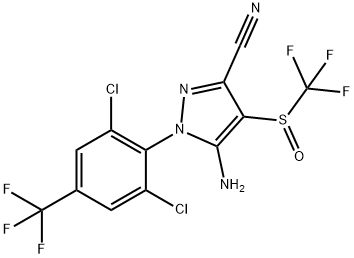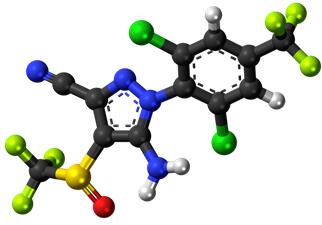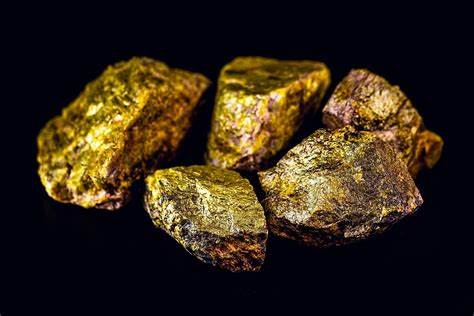The toxicity studies of fipronil
Description
Fipronil is a member of a new class of insecticides called phenylpyrazoles. Chemically, it is a (5-amino-1-[2,6-dichloro-4-(trifluoromethyl)phenyl]-4-[(trifluoromethyl)sulfinyl]-1H-pyrazole). It has a broad spectrum of activity, being used to control insect pests of crops such as rice and cotton, locusts and grasshoppers, fleas and ticks on domestic animals, and cockroaches and ants[1].
Application
The chemical structure of fipronil is shown below. Fipronil is an active ingredient of one of the popular ectoparasiticide products, Frontline. Fipronil is also present in other ectoparasiticide products, such as Certifect and Parastar Plus. There are currently two forms of Frontline preparation commercially available (a spray and a spot-on topical application) for dogs and cats. The product is meant to kill fleas and all stages of brown dog ticks, American dog ticks, lone star ticks, which may carry Lyme disease, and mites. Fipronil is used in combination with methoprene (9.8% fipronil/11.8% methoprene for cats; 9.8% fipronil/8.8% methoprene for dogs) for additional control of immature flea stages. Fipronil is also formulated as insect bait for roaches, ants, and termites, as sprays for pets, and as a granular turf product to control mole crickets. Fipronil is widely used in agriculture for soil treatment and seed coating. It is available for agricultural use as a 4.95% solution in propylene glycol under the brand name Regent 50 SC ® and is also commonly used in bait stations at much lower concentrations.

Environmental Fate
Fipronil is photolyzed into several degradates in the field by desulfinyl fipronil and fipronil sulfone. Fipronil is also rapidly metabolized to fipronil sulfone in plants. The half-life of fipronil on treated vegetation ranges from 3 to 7 months, depending on the substrate and the habitat where it is applied. Its photodegradation, volatilization, and hydrolysis are the contributors to fipronil field dissipation. Fipronil has low soil mobility. It binds to the soil and has little potential for groundwater contamination. Fipronil degrades with a half-life of 116–130 days in water and sediment that lack oxygen. Fipronil remains stable to break down in water at mildly acid to neutral pH and degrades in essential solutions with a half-life of 28 days[2]. In studies where fipronil was exposed to light, it had a half-life of 3.6 hours in water and 34 days in loamy soil.
Ecotoxicology
The toxicity of fipronil on nontarget species is variable. Fipronil is highly toxic to fish, aquatic invertebrates, bees, and some land game birds but is nearly nontoxic to particular waterfowl, earthworms, soil microorganisms, and aquatic plants. The 96 h LC50 of fipronil is 42, 85, 248, and 430 μg l−1 in African tilapia, blue gill sunfish, rainbow trout, and European carp, respectively. The LD50 is 1120 and >2150 mg kg−1 in field sparrows and mallard ducks, respectively. The low water solubility and high sediment binding of fipronil may explain this reduced toxicity in aquatic wildlife. The metabolites of fipronil have increased toxicity to birds and freshwater invertebrates compared to fipronil itself and should be used according to label directions with accompanying environmental, ecotoxicological, and human health monitoring[3].
References
[1] Fahim Mohamed. “Acute human self-poisoning with the N-phenylpyrazole insecticide fipronil–a GABAA-gated chloride channel blocker.” Journal of toxicology. Clinical toxicology 42 7 (2004): 955–63.
[2] Xilong Zhao. “Fipronil.” Journal of toxicology. Encyclopedia of Toxicology (Second Edition) (2005): 334-336.
[3]G.M. Fent. “Fipronil.” Journal of toxicology. Encyclopedia of Toxicology (Third Edition) (2014): 596-597.
);You may like
Related articles And Qustion
See also
Lastest Price from Fipronil manufacturers

US $10.00-2.00/KG2024-04-28
- CAS:
- 120068-37-3
- Min. Order:
- 1KG
- Purity:
- 99%
- Supply Ability:
- g-kg-tons, free sample is available

US $1.00/KG2024-04-23
- CAS:
- 120068-37-3
- Min. Order:
- 1KG
- Purity:
- 99.91%
- Supply Ability:
- 200000




